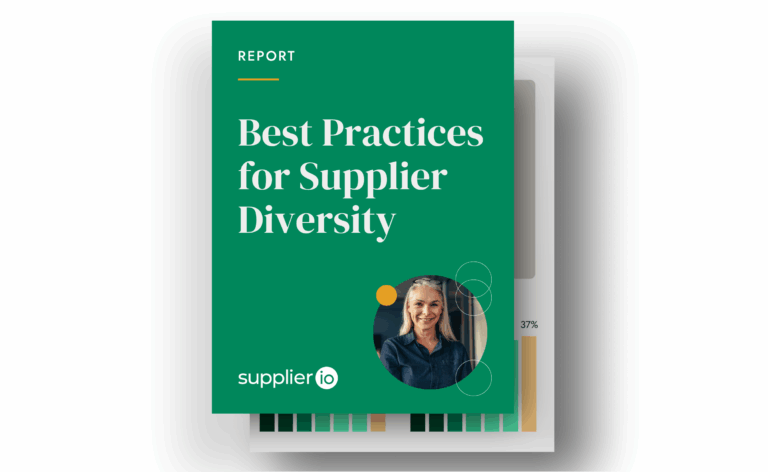Know your Sustainable Spend to Grow it – Here’s How
Maximizing supply chain sustainability requires procurement teams to properly manage and analyze their spend and supplier data. Here’s how.

Maximizing supply chain sustainability requires procurement teams to properly manage and analyze their spend and supplier data. That goes beyond just knowing how much you spend in general, but also identifying which of your suppliers are making sustainability improvements and those that aren’t. But that’s easier said than done.
The most common scenario: Suppliers take different routes to improving their sustainability requiring you to gather data from potentially multiple agencies. Some suppliers are investing in EcoVadis certification while others are working hard on improving their CDP score. Accurately assessing your suppliers and their various sustainability certifications can be difficult.
Despite the inherent challenges, knowing and reporting on ESG spend is no longer optional. Here’s what you need to know about maximizing your sustainability data and how to get started.
Procurement Runs on (Buried, Fragmented) Data
Procurement teams require reliable supplier data to effectively drive ESG spend initiatives. They need complete visibility into certifications, ratings, scores and capabilities for the supplier base to identify risks and opportunities for improvement. Data you can trust is essential in order to drive regulatory compliance, build investor confidence, scale ESG initiatives, and grow related spend. However, common challenges make it difficult for procurement teams to put this data to work. Many leaders can’t ask what they don’t know.
Pull your Data Together
For starters, spend data is often fragmented – within procurement systems (e.g., ERP and spreadsheets), within business units (e.g., accounts payable and supply chain), and with the suppliers themselves. Procurement teams can leverage supplier data management software solutions that consolidate this data into a central location to manage and analyze it.
The same is true for managing supplier sustainability data, such as assessments, certifications, scores, and surveys. Amidst a very fragmented ESG assessment and certification market, there are hundreds of these for procurement teams to collect, manage, and evaluate for their supplier base. Like managing spend data, procurement can get overwhelmed trying to apply the same rigor to their supplier certification data, which would enable them to classify their suppliers by their sustainability status.
Benchmark your Sustainable Spend Data
“Sustainable supplier” refers to a business that intentionally and consistently upholds environmental and social standards across its value chain. Thus, “sustainable spend” refers to the dollar and percentage of a company’s spend it allocates with sustainable suppliers. After all, it’s one thing to say you’re supporting sustainable businesses; it’s quite another to prove it. And for many procurement teams, that’s a big challenge and an obstacle for greater success.
To start, baseline your percentage of spend with sustainable suppliers – including Tier-2 spend. The business world speaks in terms of dollars and spend – and actual spend data is more accurate than forecasted spend. Knowing your current sustainable spend, in raw dollars and as a percentage of total spend, will help you set goals, or determine whether you’re compliant with a government contracting regulation.
Let the Data Tell its Story
Next, focus on ascertaining your supply chain’s environmental impact, including greenhouse gas (GHG) emissions. Not only will this add layers of insight about your supply chain, it will also prepare you and your company to comply with current and potential Scope-3 emissions due diligence reporting and reduction requirements.
Combine spend, category, supplier, and emissions data in a single platform to equip your team with multi-dimensional sustainability analysis (e.g., showing estimated sustainable spend versus reported or forecasted sustainable spend).
Digitize the Entire Data Management Process
Managing sustainability data and then getting the most value out of it is one of the biggest challenges in the procurement function today. The most effective approach is to implement digitized, automated ESG data management and analytics solutions that collect, cleanse, categorize, enrich, and analyze sustainable spend data, while also equipping procurement with the actionable insights required to improve.
To streamline the supplier data management and due diligence processes further, including collecting supplier certifications, procurement teams can benefit from a platform enabling:
- Data capture from multiple sources, including government agencies, certification agencies, corporate registrations, and self-registrations.
- Quality assurance that validates supplier certifications and data, and conducts reasonability checks to ensure high fidelity in the data.
- Data enrichment that blends company spend and supplier certifications and ratings to provide a more comprehensive supplier ESG profile.
- Regular updates on supplier certification, ownership, and sustainability ratings changes since enrichment.
Automated and intelligent ESG data management solutions that provide these capabilities also provide more accurate and actionable data procurement teams can trust. They enable procurement to identify opportunities to increase spend with sustainable suppliers that will give their ESG program an instant boost. What’s more, AI-enabled systems will analyze prior spend and forecasts to “learn” and identify hidden trends, and provide more accurate potential environmental-impact assessments.
Procurement can also tap internal and external partners, including suppliers, to find more sustainable and certified suppliers to fulfill the company’s requirements. Otherwise they may fail in their efforts to drive sustainable spend and demonstrate strong ESG performance.
Taking a comprehensive, digitized, and intelligent approach to data management can supercharge supply-chain ESG initiatives, including increasing spend with sustainable suppliers and closer collaboration with Tier-1 suppliers. Doing so can lead to greater legal/regulatory compliance, supply-chain resilience, expansion into new markets, and top- and bottom-line performance.
Want to learn more about the benefits of having a digital ESG data management and analytics solution? Schedule a call with us – we’re happy to help.




